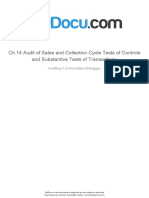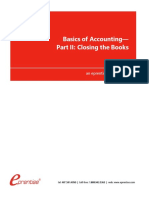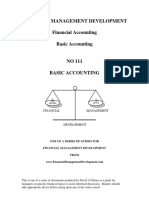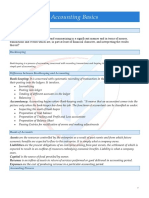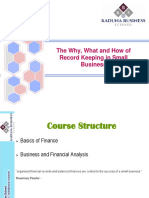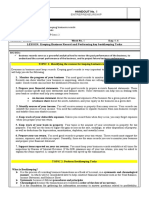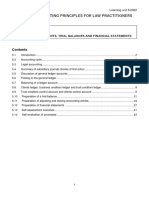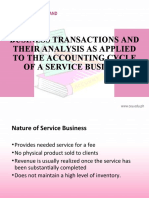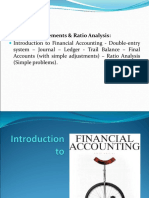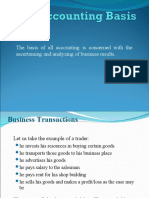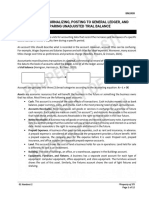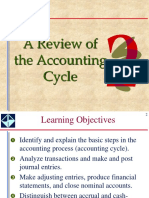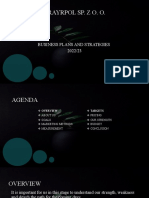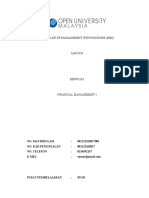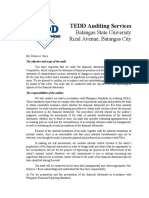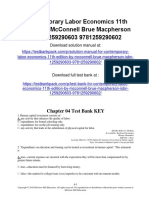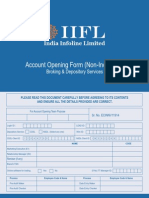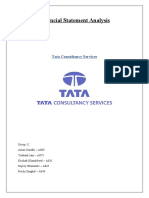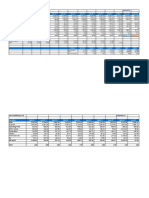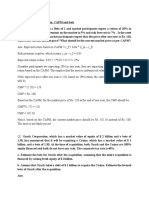FA1 Chapter3
FA1 Chapter3
Uploaded by
Abdinasir HassanCopyright:
Available Formats
FA1 Chapter3
FA1 Chapter3
Uploaded by
Abdinasir HassanOriginal Description:
Original Title
Copyright
Available Formats
Share this document
Did you find this document useful?
Is this content inappropriate?
Copyright:
Available Formats
FA1 Chapter3
FA1 Chapter3
Uploaded by
Abdinasir HassanCopyright:
Available Formats
Chapter 3
Recording, summarizing and posting
transactions
VERTEX LEARNING SOLUTIONS - https://vls-online.com
Contents
1 Recording business transactions: an overview
2 The day books
3 The general (nominal) ledger
4 Posting from the day books
5 The receivables (sales) and payables (purchases) ledgers
6 Control accounts
7 Accounting for sales tax
8 Methods of coding data
9 Manual and computerised systems
10 Batch processing and control totals
11 Accounting systems
12 Accounting modules
VERTEX LEARNING SOLUTIONS - https://vls-online.com
Recording Business Transactions: An Overview
An Overview
Business transactions are initially recorded on
source documents. Records of the details on
these documents are made in books of prime
entry.
VERTEX LEARNING SOLUTIONS - https://vls-online.com
Source Documents
Source Documents
Source documents are the source of all the information recorded by a business.
In the previous chapter we looked at the source documents which relate to sales and
purchases (invoices and credit notes). Here are some other source documents.
• Petty cash vouchers
• Cheques received
• Cheque stubs (for cheques paid out)
• Wages, salary and payroll records
VERTEX LEARNING SOLUTIONS - https://vls-online.com
Source Documents
1. Quotation
2. Purchase Order
3. Sales Order
4. Invoice
5. Debit Note
6. Credit Note
7. Journal Voucher
VERTEX LEARNING SOLUTIONS - https://vls-online.com
Recording Source Documents
Recording Source Documents
During its business, a company sends out and receives many source documents. The details on these
source documents need to be recorded, otherwise the business might forget to ask for some money, or
forget to pay some, or even accidentally pay something twice. In other words, it needs to keep records of
source documents – of transactions – so that it can keep tabs on(to monitor) what is going on.
Such records are made in books of prime entry.
The books of prime entry do not in themselves form part of the double entry system; the transactions
recorded in them are periodically summarized and then posted to the double entry ledger accounts.
VERTEX LEARNING SOLUTIONS - https://vls-online.com
Recording Transactions.
Recording Transactions.
• Transactions are first recorded in the books of
prime entry and then recorded on the ledger
system.
• A prime entry record (or book of prime entry) is
where a transaction is first recorded.
VERTEX LEARNING SOLUTIONS - https://vls-online.com
Books of Prime Entry
VERTEX LEARNING SOLUTIONS - https://vls-online.com
Question
State which books of prime entry the following transactions
would be entered.
Your business pays A Brown (a supplier) $450. (a) Cash book
You send D Smith (a customer) an invoice for $650. (b) Sales daybook
You receive an invoice from A Brown for $300 (c) Purchase daybook
You pay D Smith $500 (d) Cash book
F Jones (a customer) returns goods to the value of $250 (e) Sales returns daybook
You return goods to J Green to the value of $504 (f) Purchase returns daybook
F Jones pays you $500 (g) Cash book
VERTEX LEARNING SOLUTIONS - https://vls-online.com
What is a Ledger?
What is a Ledger?
• A ledger is an account or record used to store bookkeeping entries for balance-sheet and
income-statement transactions.
• Accounting ledger journal entries can include accounts like cash, accounts receivable,
investments, inventory, accounts payable, accrued expenses, and customer deposits.
• Accounting ledgers are maintained for all types of balance sheet and income statement
transactions.
• Balance sheet ledgers include asset ledgers such as cash or accounts receivable. Income
statement ledgers include ledgers such as revenue and expenses.
VERTEX LEARNING SOLUTIONS - https://vls-online.com
Types of Ledgers
Sales Ledger/ Purchase
Ledger/Payable General Ledger
Receivable Ledger Ledger
Land
and Cash
building
Personal Personal Real
A/R(Ali) Wages
Ledger Ledger Accounts and Inventory
salaries
(Credit (Credit Nominal
Sales Customers) Suppliers) Ledger Bank Motor
loan vehicles
A/R(David) A/R(Mohsin)
A/P(Zahid)
Purchases
A/P(Aamir)
A/P(Bilal)
VERTEX LEARNING SOLUTIONS - https://vls-online.com
What are T-Accounts?
Recording Transactions.
• In accounting we open an account for each item in our records.
• As you can see, the conventional account has the format of the letter T;
hence they are often referred to as T accounts.
• By account, we mean a summary record of all transactions relating to a
particular item in a business.
VERTEX LEARNING SOLUTIONS - https://vls-online.com
General Ledger
General Ledger
• The general ledger is simply our main ledger in accounting.
• All the main T-accounts in a business fall under the general
ledger.
• For example, land and buildings, equipment, machinery,
vehicles, financial investments, bank accounts,
VERTEX LEARNING SOLUTIONS - https://vls-online.com
Debtors Ledger and Creditors Ledger
Payables Ledger/ Creditors Receivables Ledger/Debtors
The Payables Ledger contains T-accounts The Receivables Ledger contains
for each individual creditor - meaning for T accounts for each individual debtor -
each person or business that our business meaning for each person/business that
owes. owes our business.
VERTEX LEARNING SOLUTIONS - https://vls-online.com
Summarizing Source Documents
Summarizing Source Documents
Due to the volume of source documents, and the fact that they come from and are sent to
a very large number of suppliers and customers, it is vital that the information in them is
summarized. This is done in two ways.
VERTEX LEARNING SOLUTIONS - https://vls-online.com
Posting the Ledgers
Posting the Ledgers
The process of transferring the entries from journal to respective ledger accounts is called
ledger posting. Ledger posting is entering information in the ledger, in respective accounts
from the journal for individual records.
VERTEX LEARNING SOLUTIONS - https://vls-online.com
Business Requirements
Accurate record keeping, summarizing and posting procedures enable businesses to keep
track of their day-to-day activities and provide them with vital commercial information.
Sales of goods and services, by volume and value
Expenditure incurred
Amounts owed by customers
Amounts due to suppliers
Cash and bank balances
Profits and/or losses made over a period
VERTEX LEARNING SOLUTIONS - https://vls-online.com
The Sales Day Book
The sales Day Book
• The sales daybook is a list of all invoices sent out to credit customers each day.
• The SDB is simply a list. A simple SDB would be as follows:
VERTEX LEARNING SOLUTIONS - https://vls-online.com
The Sales Returns Daybook
The Sales Returns Daybook
• When customers return goods for some reason, the returns are recorded in the sales
return's daybook.
• Sales returns could alternatively be shown as bracketed figures in the sales daybook, so
that a sales returns daybook would not be needed.
VERTEX LEARNING SOLUTIONS - https://vls-online.com
The Purchase Daybook
The Purchase Daybook
• The purchase daybook is the record of all the invoices received from suppliers.
• There is no 'invoice number' column, because the purchase daybook records other people's
invoices, which have all sorts of different numbers. Sometimes, however, a purchase daybook
may allocate an internal number to an invoice.
• (Like the sales daybook, the purchase daybook analyses the invoices which have been sent in. In
this example, three of the invoices related to goods which the business intends to re-sell (called
simply 'purchases') and the fourth invoice was an electricity bill.
VERTEX LEARNING SOLUTIONS - https://vls-online.com
The Purchase Daybook
VERTEX LEARNING SOLUTIONS - https://vls-online.com
The Purchase Returns Daybook
The Purchase Returns Daybook
• The purchase returns daybook is kept to record credit notes received in respect of goods
which the business sends back to its suppliers.
• The business might expect a credit note from the supplier. In the meantime, however, it
might issue a debit note to the supplier, indicating the amount by which the business expects
its total debt to the supplier to be reduced.
• Again, purchase returns could be shown as bracketed figures in the purchase daybook.
VERTEX LEARNING SOLUTIONS - https://vls-online.com
The Purchase Returns Daybook
VERTEX LEARNING SOLUTIONS - https://vls-online.com
Purchase Day Book
Purchase A/C
Purchase Day Book
Date Particulars Invoice no. Amount
Mr. A a/c $10000
Mr. B a/c $5000
Mr. C a/c $15000 - Mr. A a/c +
TOTAL $25000 Purchase $10000
- Mr. B a/c +
Purchase $5000
Special Journal mentioned to record transactions relating to
purchase of goods on credit is called Purchase Day Book.
- Mr. C a/c +
The entries in the purchase book are made based on + Purchase a/c - Purchases $15000
purchases invoices received from suppliers.
Total Payables $25000
as per
purchase book
Also known as inward invoices
VERTEX LEARNING SOLUTIONS - https://vls-online.com
Purchase Day Book
Posting of
Purchase Book Purchase Book
Posting of an
Posting of
individual Recorded Not Recorded
periodic total
amount
1. Cash purchases
Posted to the of anything
Posted to the Only credit purchases
credit of
debit of purchase of goods/inventory 2. Credit purchases
supplier's of Assets not for
A/C
account resale
VERTEX LEARNING SOLUTIONS - https://vls-online.com
Sales Day Book
Sales A/C
Purchase Day Book
Date Particulars Invoice no. Amount
Mr. X a/c $1200
Mr. Y a/c $17500 + Mr. X a/c -
Mr. Z a/c $2000 Sales $1200
TOTAL $20700
+ Mr. Y a/c -
Sales $17500
Special Journal mentioned to record transactions relating to
sales of goods on credit is called Sales Day Book.
+ Mr. Z a/c -
The entries in the sales book are made on the basis of sales - Sales A/C + Sales $2000
invoices sent to customers.
Total receivables $20700
as per
sales book
Also known as outward invoices
VERTEX LEARNING SOLUTIONS - https://vls-online.com
Sales Day Book
Posting of
Sales Book
Sales Book
Posting of an
Posting of
individual
periodic total Recorded Not Recorded
amount
Posted to the
Posted to the
debit of Only credit sales of 1. Cash sales of
credit of sales
customer's goods/inventory anything
A/C
account
VERTEX LEARNING SOLUTIONS - https://vls-online.com
The Cash Book
The Cash Book
• The cash book is a book of prime entry, used to keep a cumulative record of money received and
money paid out by the business via its bank account.
• This could be money received on the business premises in notes, coins and cheques which are
subsequently banked. There are also receipts and payments made by bank transfer, standing order,
direct debit, automatic credit transfer and, in the case of bank interest and charges, directly by the
bank.
• It is usual to maintain one main cash book to record the amounts received and paid through the
business bank account.
VERTEX LEARNING SOLUTIONS - https://vls-online.com
The Cash Book
The Cash Book
• The 'cash' referred to in the title of the book will therefore consist normally of cheques, rather
than notes and coins, depending on the nature of the business. But most businesses need a
supply of notes and coins to pay for small everyday expenses such as postage, tea and coffee
and so on. These amounts are usually recorded in a separate book of prime entry called a petty
cash book.
• One part of the cash book is used to record receipts of cash, and another part is used to record
payments.
VERTEX LEARNING SOLUTIONS - https://vls-online.com
Balancing the Cash Book
At the beginning of the day there is a debit opening balance of $900. During the day,
the total receipts and payments were as follows.
VERTEX LEARNING SOLUTIONS - https://vls-online.com
Balancing the Cash Book
The closing balance of $780 represents the excess of receipts over payments. It means
business still has cash available at the end of the day,
Accountants generally use the terminology 'balance brought down' or 'balance b/d' and
'balance carried down' or 'balance c/d' instead of 'opening balance' and 'closing balance'.
VERTEX LEARNING SOLUTIONS - https://vls-online.com
Bank Statements
Bank Statements
All bank accounts have bank statements issued at regular
intervals. A business should reconcile its cash book with
the bank statement, to ensure that no cash has 'gone
missing'.
VERTEX LEARNING SOLUTIONS - https://vls-online.com
Question
Which of the following will not be entered in the cash book?
(a) Cheque received
(b) Payment to receivables ledger customers
(c) Supplier's invoice
(d) Credit note
(e) Debit note
(f) Bank charges debited to the bank account
(g) Overdraft interest debited to the bank account
(h) Payment for a non-current asset purchased on credit
(i) Refund received from a supplier
(j) Depreciation
VERTEX LEARNING SOLUTIONS - https://vls-online.com
Answer
The cash book records money received, and money paid. If something does not involve
money coming into or going out of the business, it will not result in an entry in the cash
book. The following will not be entered in the cash book.
(c) Supplier's invoice
(d) Credit note
(e) Debit note
(j) Depreciation
VERTEX LEARNING SOLUTIONS - https://vls-online.com
Petty Cash Book
Petty Cash Book
• Most businesses keep a small amount of cash on the premises to make occasional small payments
in cash – e.g., to pay the milkman, to buy a few postage stamps, or to pay for some bus or taxi
fares. This is often called the cash float. It can also be the resting place for occasional small
receipts, e.g., cash paid by a visitor to make a phone call.
• The petty cash book is the book of prime entry which keeps a cumulative record of the small
amounts of cash received into and paid out of the cash float.
• There are usually more payments than receipts, and petty cash must be 'topped-up' with cash
from the business bank account.
VERTEX LEARNING SOLUTIONS - https://vls-online.com
Petty Cash Book
VERTEX LEARNING SOLUTIONS - https://vls-online.com
The General (Nominal) Ledger
The General (Nominal) Ledger
The general ledger is the accounting record which summarizes the financial affairs of a
business. It contains details of assets, liabilities and capital, income and expenditure and so
profit and loss. It consists of many different ledger accounts, each account having its own
purpose or 'name‘ and an identity or code. Another name for the general ledger is the
nominal ledger.
VERTEX LEARNING SOLUTIONS - https://vls-online.com
The General (Nominal) Ledger
Examples of ledger accounts in the general ledger include the following.
VERTEX LEARNING SOLUTIONS - https://vls-online.com
Control Accounts
Control Accounts
• A control account is an account in the general ledger in which a record is kept of the total value of
several similar but individual items.
• A receivables control account is an account in which records are kept of transactions involving all
receivables in total. It is posted with totals from the sales daybook and the cash book.
• A payables control account is an account in which records are kept of transactions involving all
payables in total, being posted with totals from the purchase's daybook and the cash book.
VERTEX LEARNING SOLUTIONS - https://vls-online.com
Discounts
Discount Allowed Discount Received
• Discount allowed is a sales discount • Discount allowed is a purchase
given to the customers. discount given by the suppliers.
• It’s treated as an expense • It’s treated as an income
Double Entry: Double Entry:
Dr Cr Dr Cr
Accounts Receivable $100 Purchases $110
Sales discount $10 Purchase discount $10
Sales $110 Accounts Payable $100
VERTEX LEARNING SOLUTIONS - https://vls-online.com
General Principles of Sales Taxes
General Principles of Sales Taxes
• The basic principle is that businesses operate as the agent of the tax authority collecting the tax on
their behalf and paying it over to them on a regular basis.
• The rates of sales tax around the world vary, and therefore the percentage sales tax used in the
exam may vary as well. However, it is not the amount of the tax that is important for the exam, but
a keen understanding of the principles involved in accounting for that tax, whatever the rate may
be. You will always be given the relevant rate in the exam, and you must use this for your
calculations.
VERTEX LEARNING SOLUTIONS - https://vls-online.com
Sales Tax
Sales tax rules can be quite complex, but the following are the main points to remember.
Output sales tax is charged on sales and input sales tax is incurred on purchases
Input Tax Output Tax
Input tax is the tax paid by registered Output tax is the tax that a VAT registered
person on the taxable goods and services business is required to charge on its taxable
purchased or acquired by him. This also sales.
includes the sales tax paid on imports. Seller charges on behalf of tax authority.
Buyer pays.
VERTEX LEARNING SOLUTIONS - https://vls-online.com
Sales Tax
Supplier Sales Tax Registered Seller Customer
$80 + tax $100 + tax
Output Tax
Input Tax
Input tax is paid by buyer while purchasing. Out tax seller charges on sale..
The seller already paid to The seller collects it on behalf
the government. of tax authority.
Net amount payable to the government = output tax – input tax
VERTEX LEARNING SOLUTIONS - https://vls-online.com
Calculation of Sales Tax
Net sales price (exclusive of tax)+ rate = gross sales value(inclusive of tax)
Net Gross
20%
value Value
$100 $20 $120
$180 $216
$360
0 0
VERTEX LEARNING SOLUTIONS - https://vls-online.com
Example – Sales Tax Calculation
A summary of the transactions of David, who is registered for sales tax at 17.5%, shows the following for the
month of August 20X9.
Outputs $50,000 (exclusive of sales tax)
Inputs $34,120 (inclusive of sales tax)
At the beginning of the period David owed $5,400 to the taxation authorities, and during the period he has
paid $5,800 to them.
At the end of the accounting period, what is the amount due
to the taxation authorities?
A $3,700
B $3,930
C $4,400
D $5,300
VERTEX LEARNING SOLUTIONS - https://vls-online.com
Basic Calculation of Sales Tax
Whenever a sales tax registered business sells anything, it must
charge its customers sales tax on all goods or services to which the
tax applies. List price $50.00
Less: trade discount $5.00
Less: settlement discount $1.35
The basic calculation is to take a percentage of the invoice total (after (i.e., 3% × $45.00)
deducting any trade discounts) and to round this amount down to the
nearest cent or penny.
––––––
So, for goods with a list price of $50.00 on which a 10% trade Net $43.65
discount is allowed, and settlement discount of 3% (which was
expected to be taken up by the customer) the net amount would be
$43.65 on which sales tax at the appropriate rate calculated and
added.
VERTEX LEARNING SOLUTIONS - https://vls-online.com
Sales Tax Requirement
If a business is sales tax registered, then it must charge sales tax on its sales and must issue a sales
tax invoice. To be a valid sales tax invoice, certain information must be included on the invoice.
Registration number Tax point Rate of sales tax
All sales tax registered The tax point on an invoice is The rate of sales tax on an
businesses will have a unique the date when a transaction is invoice must be shown. Rates
registration number. The deemed to have taken place vary from country to country
requirement to include this
number on the invoice for sales tax purposes. It and some countries may have
enables the tax authorities to enables the tax on the more than one rate. The rate
determine whether the transaction to be recorded in you need to apply in the exam
invoice came from a valid the correct accounting will be given to you.
registered business. period. Usually, the tax point
is the invoice date.
VERTEX LEARNING SOLUTIONS - https://vls-online.com
Accounting for Sales Tax
Sales Tax and Sales
A business does not keep the output sales tax it
charges – it pays it back to the tax authority. It
therefore follows that its records of sales should not
include sales tax.
VERTEX LEARNING SOLUTIONS - https://vls-online.com
Example: Accounting for Output Sales Tax
If a business sells goods for $600 + $120 sales tax, i.e., for $720 gross price, the sales account should
only record the $600 excluding sales tax. The accounting entries for the sale would be as follows.
DEBIT Cash or trade accounts receivable $720
CREDIT Sales $600
CREDIT Sales tax account (output sales tax) $120
VERTEX LEARNING SOLUTIONS - https://vls-online.com
Sales Tax and Sales
Similarly, the business does not want to show input tax paid on purchases as
a cost of the business – it must reclaim it from the government. However, the
cost of purchases in the statement of profit or loss may or may not include
the 'input' tax paid, depending on whether the input tax is recoverable.
VERTEX LEARNING SOLUTIONS - https://vls-online.com
Sales Tax and Sales
(a) If input tax is recoverable, the cost of purchases should exclude the tax. For example, if a business
purchases goods on credit for $400 + recoverable tax $80, the transaction would be recorded as
follows.
DEBIT Purchases $400
DEBIT Sales tax account (input tax) $80
CREDIT Trade accounts payable $480
(b) If the input tax is not recoverable, the cost of purchases must include the tax, because it is the
business itself which must bear the cost of the tax.
DEBIT Purchases $480
CREDIT Trade accounts payable $480
VERTEX LEARNING SOLUTIONS - https://vls-online.com
Sales Tax in Credit Transactions
Purchases Sales
$ $
Purchase cost 200 Sales income 200
Sales tax 40 Sales tax 40
Total 240 Total 240
VERTEX LEARNING SOLUTIONS - https://vls-online.com
Sales Tax in Cash Transactions
Tax charged on cash sales or tax paid on cash purchases will be analyzed in a
separate column of the cash book. This is because output tax, having just
arisen from the cash sale, must be credited to the sales tax account.
VERTEX LEARNING SOLUTIONS - https://vls-online.com
The Sales Tax Account
The tax paid to or recovered from the authorities each quarter is the balance on
the sales tax account.
This is a control account to which these items are posted.
VERTEX LEARNING SOLUTIONS - https://vls-online.com
The Sales Tax Account
Payments to or refunds from the government do not coincide with the end of the accounting period of a
business, and so at the financial reporting date there will be a balance on the sales tax account. The
balance is usually for an amount payable to the government, i.e. an outstanding payable for sales tax.
Occasionally, a business will be owed money back by the government, and the tax refund will be an
amount receivable from the government.
VERTEX LEARNING SOLUTIONS - https://vls-online.com
Methods of Coding Data
Each account in an accounting system has a unique code to identify the correct account for posting.
Coding also saves time in copying out data because codes are shorter than 'longhand' descriptions. For the
same reason, and to save storage space, computer systems make use of coded data.
In accounting systems, the most obvious examples of codes are as follows.
Customer account numbers
Supplier account numbers
General ledger account numbers
Employee reference numbers
Inventory item codes
These are all codes a business sets up and applies internally. External codes which affect the business include
bank account numbers
VERTEX LEARNING SOLUTIONS - https://vls-online.com
Methods of Coding Data
A general ledger will consist of many coded accounts. For example, part of a general ledger might
be as follows.
VERTEX LEARNING SOLUTIONS - https://vls-online.com
Manual and Computerized Systems
We have looked at the way an accounting system is organized in
the last few chapters. It is important to realize that all of the
books of prime entry and the ledgers may be either hand-written
books or computer records. Most businesses now use computers,
ranging in size from one PC used by a one-man business to huge
mainframe computer systems used by multi-national companies.
VERTEX LEARNING SOLUTIONS - https://vls-online.com
Computer Activity
All computer activity can be divided into three processes.
VERTEX LEARNING SOLUTIONS - https://vls-online.com
Data Entry Errors
Transcription errors, for example entering '45' as '54', adding an extra zero to a figure,
entering dates in the wrong format
Source documents can be damaged or destroyed
Accuracy of data entry
is vital but there are Poor handwriting can make forms difficult to read
various ways in which
errors and omissions Details can be omitted or incorrect in the source document, e.g., wrong code,
can be made, for date, price
example:
Poorly skilled staff
Malicious intent
VERTEX LEARNING SOLUTIONS - https://vls-online.com
Reducing Data Entry Errors
Automatic
data entry Well-designed
Properly Well- data entry Using tick Avoiding long Verification by
such as entering the data
trained and designed screens that boxes or sequences of Validation
scanning mirror the source
twice and
experienced forms that are drop-down numerical checking for techniques
avoids document for
staff easy to read lists characters inconsistencies
transcription ease of entry
errors
VERTEX LEARNING SOLUTIONS - https://vls-online.com
Validation Techniques
Validation of data ensures that it is reasonable and possible but not that it is necessarily correct.
Data that is valid, for example a monetary amount that has no more that two decimal places, can
still be an incorrect monetary amount if it is entered as '$123.45' instead of the correct '$312.45’.
The following are examples of techniques that can be used to ensure that the data entered onto a
computer system is valid. Invalid data will be rejected by the system if they fail these checks.
VERTEX LEARNING SOLUTIONS - https://vls-online.com
Validation Techniques
Field presence Essential fields cannot be left blank e.g., customer delivery address
Field length Data has the correct number of characters (minimum and maximum) e.g., a date must
have a minimum of six numeric characters as in 15.12.10
Data value is within a predetermined range e.g., months of the year must be within the
Range range 1 to 12
Format Individual characters are valid e.g., a customer account number must be in the
format AAA/999 (three letters, slash, three numbers)
Batch header Where batch processing is used the computer calculates totals that can be matched to
the totals of the documents in the batch
Code numbers such as bank account numbers are likely to data entry errors. Check
Check digit digits are extra digits in a code, calculated by the computer using an algorithm, to check
that the other digits in the code are correct.
VERTEX LEARNING SOLUTIONS - https://vls-online.com
Batch Processing and Control Totals
Batch processing is where similar transactions are gathered into batches, and then each batch is sorted and
processed by the computer.
Rather than inputting individual invoices into a computer for processing, which would be time consuming and
expensive, invoices can be gathered into a batch and input and processed all together.
Batches can vary in size, depending on the type and volume of transactions and on any limit imposed by the system
on batch sizes. This type of processing is less time consuming than transaction processing, where transactions are
processed individually as they arise.
Control totals are used to make sure that there have been no errors when the batch is input. A control total is used
to make sure that the total value of transactions input is the same as that previously calculated.
VERTEX LEARNING SOLUTIONS - https://vls-online.com
Accounting Systems
In principle computerized accounting is the same as manual accounting, but a computerized approach
has certain advantages which you should learn thoroughly.
The most important point to remember is that the principles of computerized accounting are the
same as those of manual accounting. You should by now have a good grasp of these principles.
An accounting package consists of several accounting modules, e.g., receivables ledger, cash book. An
exam question may take one of these modules and ask you to describe inputs, processing and outputs.
A particularly useful tool for accountants is the spreadsheet. It is likely that you will have used a
spreadsheet in your workplace.
Computer programs are the instructions that tell the electronics how to process data. The general
term used for these is software.
VERTEX LEARNING SOLUTIONS - https://vls-online.com
Accounting Systems
Software is what we are concerned with in this Interactive Text, and in particular 'applications
software', that is packages of computer programs that carry out specific tasks.
(a) Some applications are devoted specifically to an accounting task, for example a payroll
package, a non-current asset register or an inventory control package.
(b) Other applications have many uses in business, including their use for accounting purposes.
Examples are databases and spreadsheets.
VERTEX LEARNING SOLUTIONS - https://vls-online.com
Accounting Packages
ADVANTAGES DISADVANTAGES
• (a) The packages can be used by non-specialists. • (a) The initial time and costs involved in installing
the system, training personnel and so on.
• (b) A large amount of data can be processed very
• (b) The need for security checks to make sure that
quickly.
unauthorized personnel do not gain access to data
• (c) Computerized systems are more accurate than files.
manual systems. • (c) The necessity to develop a system of coding and
checking.
• (e) Once the data has been input, computerized
systems can analyze data rapidly to present useful • (d) Lack of 'audit trail'. It is not always easy to see
where a mistake has been made.
control information for managers such as a trial
balance or a receivables schedule. • (e) Possible resistance on the part of staff to the
introduction of the system.
VERTEX LEARNING SOLUTIONS - https://vls-online.com
Coding
Computers are used more efficiently if vital information is expressed in the form of codes. For example, general
ledger accounts will be coded individually, perhaps by means of a two-digit code: e.g.
00 Sales
01 Non-current assets
05 Expenses
15 Purchases
22 Receivables ledger control account
41 Payables ledger control account
42 Interest
43 Inventory etc
In the same way, individual accounts must be given a unique code number in the receivable's ledger and payables
ledger.
VERTEX LEARNING SOLUTIONS - https://vls-online.com
Example: Coding
When an invoice is received from a supplier (code 1234) for $3,000 for the purchase
of raw materials, the transaction might be coded for input to the computer as:
Code 15 might represent purchases and code 41 the payables control account.
VERTEX LEARNING SOLUTIONS - https://vls-online.com
Modules
Modules
• A module is a program which deals with one part of a business accounting system.
• An accounting package will consist of several modules. A simple accounting package
might consist of only one module (in which case it is called a stand-alone module),
but more often it will consist of several modules. The name given to a set of several
modules is a suite. An accounting package, therefore, might have separate modules
for:
VERTEX LEARNING SOLUTIONS - https://vls-online.com
Modules
Invoicing
Inventory
Receivables ledger
Payables ledger
General ledger
Payroll
Cash book
Job costing
VERTEX LEARNING SOLUTIONS - https://vls-online.com
Integrated Software
Integrated Software
Each module may be integrated with the others, so that data entered in one
module will be passed automatically or by simple operator request through
into any other module where the data is of some relevance. For example, if
there is an input into the invoicing module authorizing the dispatch of an
invoice to a customer, there might be automatic links:
VERTEX LEARNING SOLUTIONS - https://vls-online.com
Accounting Module
ADVANTAGES DISADVANTAGES
• (a) It becomes possible to make just one • (a) Usually, it requires more computer
entry in one of the ledgers which memory than separate (stand-alone)
systems – which means there is less
automatically updates the others.
space in which to store actual data.
• (b) Users can specify reports, and the • (b) Because one program is expected to
software will automatically extract the do everything, the user may find that an
required data from all the relevant files. integrated package has fewer facilities
than a set of specialized modules. In
• (c) Both of the above simplify the effect, an integrated package could be
workload of the user. 'Jack of all trades but master of none'.
VERTEX LEARNING SOLUTIONS - https://vls-online.com
Accounting Modules
Accounting Modules
An accounting package consists of a number of
'modules' which perform all the tasks needed to
maintain a normal accounting function like payables
ledger or payroll. In modern systems the modules are
usually integrated with each other.
VERTEX LEARNING SOLUTIONS - https://vls-online.com
You might also like
- Grdae 9 - Ems - Financial Literacy SummaryDocument17 pagesGrdae 9 - Ems - Financial Literacy SummarykotolograceNo ratings yet
- Chapter-2 Accounting CycleDocument18 pagesChapter-2 Accounting CycleTsegaye BelayNo ratings yet
- Welcome To Our 2-Day TrainingDocument44 pagesWelcome To Our 2-Day Trainingcjbesmonte01No ratings yet
- Accounting at A GlanceDocument14 pagesAccounting at A GlanceNiyaz AhamedNo ratings yet
- CH 14 Audit of Sales and Collection Cycle Tests of Controls and Substantive Tests of TransactionsDocument11 pagesCH 14 Audit of Sales and Collection Cycle Tests of Controls and Substantive Tests of TransactionsAldwin CalambaNo ratings yet
- Accounting Equation and Double Entry BookkeepingDocument29 pagesAccounting Equation and Double Entry BookkeepingArvin ToraldeNo ratings yet
- Recording of Transactions-Voucher System, Accounting Process, JournalDocument53 pagesRecording of Transactions-Voucher System, Accounting Process, JournalMishika WadhwaniNo ratings yet
- Lesson 2 - Recording The Business TransactionsDocument6 pagesLesson 2 - Recording The Business TransactionsUnknownymousNo ratings yet
- 2.accounting (Financial Accounting)Document6 pages2.accounting (Financial Accounting)Asjad JamshedNo ratings yet
- Basic Accounting For IT Part IIDocument4 pagesBasic Accounting For IT Part IImailbag6100% (1)
- Chap 1-4Document11 pagesChap 1-47a4374 hisNo ratings yet
- Nadiatul - Summary Week 5Document4 pagesNadiatul - Summary Week 5nadxco 1711No ratings yet
- Chap 22Document13 pagesChap 22Hemant GhugeNo ratings yet
- CHAPTER 1 - PPT Intro To AccountingDocument14 pagesCHAPTER 1 - PPT Intro To AccountingAmrinNo ratings yet
- Accounting Package enDocument29 pagesAccounting Package enaryakundal2No ratings yet
- Double-Entry Book-KeepingDocument6 pagesDouble-Entry Book-KeepingFarman AfzalNo ratings yet
- Chapter 3 Ledger Accounting and Double EntryDocument35 pagesChapter 3 Ledger Accounting and Double Entrylerotholiletsie523No ratings yet
- Financial Management Development Financial Accounting Basic AccountingDocument8 pagesFinancial Management Development Financial Accounting Basic AccountingPururaja AjsNo ratings yet
- As Level Accounting Notes.Document75 pagesAs Level Accounting Notes.SameerNo ratings yet
- As Level Accounting NotesDocument77 pagesAs Level Accounting NotesRoHan ChooramunNo ratings yet
- FA1 Chapter 3 PDFDocument7 pagesFA1 Chapter 3 PDFPrincess ThaabeNo ratings yet
- Basics of Accounting in Small Business NewDocument50 pagesBasics of Accounting in Small Business NewMohammed Awwal NdayakoNo ratings yet
- EntrepreneurshipHandout Week 5Document6 pagesEntrepreneurshipHandout Week 5Pio GuiretNo ratings yet
- The Accounting FundamentalsDocument7 pagesThe Accounting Fundamentals7a4374 hisNo ratings yet
- Fac Lu5Document43 pagesFac Lu5chloelazarus619No ratings yet
- Journal Practice (Accounting)Document11 pagesJournal Practice (Accounting)arafatchan4189No ratings yet
- Accounting BasicsDocument21 pagesAccounting BasicsasifparwezNo ratings yet
- The Accounting CycleDocument17 pagesThe Accounting Cycleyuvita prasadNo ratings yet
- By: Ms. Pakeezah ButtDocument18 pagesBy: Ms. Pakeezah ButtHusnain MustafaNo ratings yet
- Audit Oracle Using ACLDocument9 pagesAudit Oracle Using ACLWing Wahyu WinarnoNo ratings yet
- 2.double-Entry Recording Process - CLCDocument48 pages2.double-Entry Recording Process - CLCTrang NguyenNo ratings yet
- Business Transactions and Their Analysis As Applied To The Accounting Cycle of A Service BusinessDocument61 pagesBusiness Transactions and Their Analysis As Applied To The Accounting Cycle of A Service BusinessAizle Trixia AlcarazNo ratings yet
- Ncert Sol Class 11 Accountancy Chapter 11Document39 pagesNcert Sol Class 11 Accountancy Chapter 11rajniya07No ratings yet
- Quick Summary of Accounting CH WiseDocument58 pagesQuick Summary of Accounting CH Wisesyedabdullaha28No ratings yet
- Double Entry System Journal Entries Part 1Document11 pagesDouble Entry System Journal Entries Part 1Jahanzaib ButtNo ratings yet
- Financial Accounting - Information For Decisions - Session 1 - Chapter 2 PPT pBGEaElvpiDocument27 pagesFinancial Accounting - Information For Decisions - Session 1 - Chapter 2 PPT pBGEaElvpimukul3087_305865623No ratings yet
- Book KeepingDocument11 pagesBook KeepingRocket SinghNo ratings yet
- Accounting and FinanceDocument51 pagesAccounting and FinanceVIGNESH MBANo ratings yet
- Course: Principles of Accounting and Economics Chapter 3: Accounting CycleDocument23 pagesCourse: Principles of Accounting and Economics Chapter 3: Accounting CyclemoallimNo ratings yet
- Business Transactions and Their Analysis As Applied To The Accounting Cycle of A Service BusinessDocument41 pagesBusiness Transactions and Their Analysis As Applied To The Accounting Cycle of A Service BusinessRoxe X100% (1)
- Lecture 1 - 2-Basics of AccountingDocument29 pagesLecture 1 - 2-Basics of AccountingRavi KumarNo ratings yet
- Financial AccountingDocument53 pagesFinancial Accountingnikhil100% (1)
- Lecture 2 Sources Records Books of Prime EntryDocument31 pagesLecture 2 Sources Records Books of Prime EntryJohnson MvududuNo ratings yet
- The Basis of All Accounting Is Concerned With The Ascertaining and Analyzing of Business ResultsDocument42 pagesThe Basis of All Accounting Is Concerned With The Ascertaining and Analyzing of Business ResultsAswin S PanickerNo ratings yet
- PYQ FlashcardsDocument48 pagesPYQ Flashcardskala1975No ratings yet
- 01 Handout 2Document12 pages01 Handout 2galangroxanne00No ratings yet
- Computer Based Accounting in HindiDocument35 pagesComputer Based Accounting in HindisunnyNo ratings yet
- Best Practices For Oracle ReceivablesDocument31 pagesBest Practices For Oracle ReceivablesHussein SadekNo ratings yet
- Financial Accounting: PGP-1 June 2010Document29 pagesFinancial Accounting: PGP-1 June 2010Sukeerth ThodimaladinneNo ratings yet
- Chapter Two - Fundamentals of AcctDocument14 pagesChapter Two - Fundamentals of AcctGedionNo ratings yet
- CH 3 - Journal Entries and PostingDocument63 pagesCH 3 - Journal Entries and Postingmr.black.543oNo ratings yet
- A Review of The Accounting CycleDocument46 pagesA Review of The Accounting CycleLiezl MaigueNo ratings yet
- Unit IiDocument20 pagesUnit IinamianNo ratings yet
- Accounting PackageDocument148 pagesAccounting PackagenafeesNo ratings yet
- Module 2 - The Use of Double-Entry and Accounting SystemsDocument22 pagesModule 2 - The Use of Double-Entry and Accounting SystemsJewel Philip50% (2)
- Transaction Processing: I. The Data Processing CycleDocument6 pagesTransaction Processing: I. The Data Processing Cyclejudel ArielNo ratings yet
- Lecture Note F3 - Part 1Document45 pagesLecture Note F3 - Part 1mai linhNo ratings yet
- IEAS W Grade 11 Accountancy Chapter 3Document32 pagesIEAS W Grade 11 Accountancy Chapter 3Zainab NaginaNo ratings yet
- Bookkeeping And Accountancy Made Simple: For Owner Managed Businesses, Students And Young EntrepreneursFrom EverandBookkeeping And Accountancy Made Simple: For Owner Managed Businesses, Students And Young EntrepreneursNo ratings yet
- Chapter 3Document14 pagesChapter 3Gabriel Garza100% (4)
- Business StrategyDocument13 pagesBusiness StrategySuman BhurtelNo ratings yet
- Bachelor of Management With Honours (Bim)Document18 pagesBachelor of Management With Honours (Bim)Aizat AhmadNo ratings yet
- Fleming - Ritik-Accounting SopDocument5 pagesFleming - Ritik-Accounting SopSarabjeet KaurNo ratings yet
- Economics Project Final Draft 2nd SemDocument19 pagesEconomics Project Final Draft 2nd SemRishabh BhandariNo ratings yet
- TEDD Auditing Services: Batangas State University Rizal Avenue, Batangas CityDocument3 pagesTEDD Auditing Services: Batangas State University Rizal Avenue, Batangas CityandengNo ratings yet
- Session 5 Security Market IndicesDocument50 pagesSession 5 Security Market IndicesUjjwal AiranNo ratings yet
- Corporate Governance ModelsDocument34 pagesCorporate Governance ModelsRagveer SinghNo ratings yet
- Asef Khademi - 3Document16 pagesAsef Khademi - 3Asef KhademiNo ratings yet
- Sunil PayslipDocument1 pageSunil PayslipSiyaram MeenaNo ratings yet
- Contemporary Labor Economics 11th Edition McConnell Test Bank 1Document19 pagesContemporary Labor Economics 11th Edition McConnell Test Bank 1patricia100% (37)
- SSRN Id2036979Document26 pagesSSRN Id2036979aukie999No ratings yet
- IIFL Account Opening Form Non-IndividualDocument36 pagesIIFL Account Opening Form Non-IndividualidkwhiiNo ratings yet
- Banking The Unbanked: Native American BankDocument4 pagesBanking The Unbanked: Native American BankjjNo ratings yet
- United States Securities and Exchange Commission v. MuskDocument23 pagesUnited States Securities and Exchange Commission v. MuskCNBC.com100% (2)
- Jellyfish - 2024 Annual Budget Planning Guide For Software Engineering - Ebook - FDocument16 pagesJellyfish - 2024 Annual Budget Planning Guide For Software Engineering - Ebook - FRusso2686No ratings yet
- The Audit ProcessDocument20 pagesThe Audit ProcessmavhikalucksonprofaccNo ratings yet
- Report On GoldDocument24 pagesReport On GoldSagar PanchalNo ratings yet
- Group 12 FA AssignmentDocument13 pagesGroup 12 FA AssignmentAthul KishanNo ratings yet
- Internship Report On Allied BankDocument83 pagesInternship Report On Allied BankIrfan HaiderNo ratings yet
- Eeb P1Document26 pagesEeb P1Manaa YosraNo ratings yet
- Tata ChemicalsDocument10 pagesTata ChemicalsPriyabrataTaraiNo ratings yet
- Satisfactory VoucherDocument1 pageSatisfactory Vouchervrevatienterprises100% (2)
- 2021 Tutorial 3Document7 pages2021 Tutorial 3Ashish KumarNo ratings yet
- BUSS1030 MSE Question AnswersDocument4 pagesBUSS1030 MSE Question AnswersDharniNo ratings yet
- Bus Alevel Aqa Calccards SampleDocument11 pagesBus Alevel Aqa Calccards Sampletalha ubaidNo ratings yet
- Transfer Pricing A Quick Run Through 1668336077 PDFDocument16 pagesTransfer Pricing A Quick Run Through 1668336077 PDFHafisMohammedSahibNo ratings yet
- ABC Blue PrintDocument80 pagesABC Blue Printanand chawan100% (1)
- 4 DigestDocument2 pages4 DigestRey Almon Tolentino AlibuyogNo ratings yet
- Martires vs. ChuaDocument1 pageMartires vs. ChuaZandra LeighNo ratings yet




